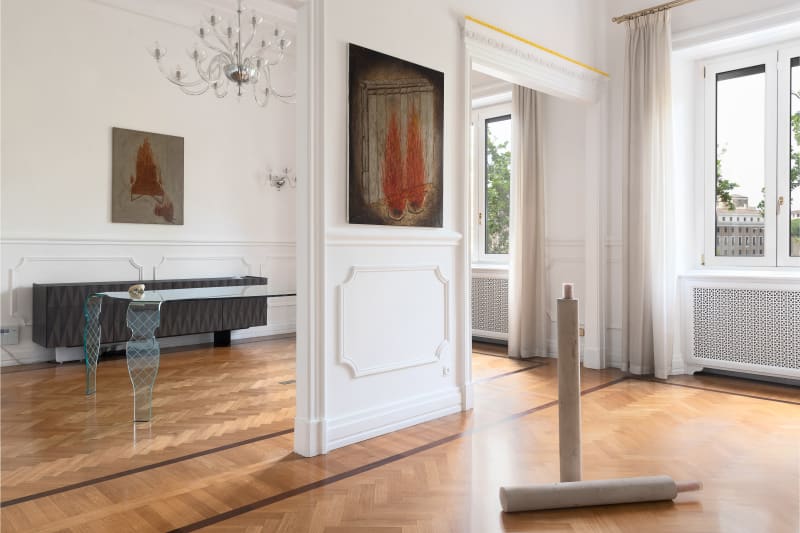In the dim light of Piano d’ascolto, Andreas Zampella invites us into a world where the act of listening is as vital as the act of seeing. This is not an exhibition where the works stand still for us to observe. Rather, they observe us, capturing us in a space that refuses to be fixed, a space that keeps us guessing, always questioning: Am I inside or outside this performance?
Zampella's paintings—built from layers of memory, destruction, and rebirth—are not mere objects; they are spaces in flux, as fleeting and disorienting as the very nature of existence. The “Sipario verde” (2016–2022) asks us to confront the notion of home: what happens when the familiar, the safe, the known begins to burn, dissolving before our eyes? Are we witnessing the end of something, or the beginning of a metamorphosis? Zampella’s work is a theater where the boundaries between spectator and actor are blurred, and identity itself becomes a shifting mask.
There is a violence in Zampella’s art—a brutal honesty that echoes the Viennese Actionism of the past, yet it is tempered with the Mediterranean irony and wisdom of the picaro. Here, in his mixed-media sculptures and paintings, flesh becomes entangled with stone and resin, as though the very essence of the human body is pressing against the confines of existence, struggling to break free from the straitjackets of societal norms and internalized constraints. Incastro (2022) shows us this struggle—a visceral, tactile resistance, an ongoing fight with the boundaries that define us.
Through his intricate symbolism, Zampella presents us with the remains of a world that never stops observing, even as it sinks. Disembodied limbs and fragments of furniture evoke the worn-out objects that mark our passage through time, while the calendar (2021) reminds us that the passage of days is a theatrical spectacle—one in which we are all actors, unable to leave, even as we yearn for escape.
The human figure in Zampella’s work is not a passive object, but an active participant in the play of existence. In Passaggio tra le sfingi (2022), a solitary figure rides a bicycle, trapped in motion, but stopped in its tracks by sentinels—guard dogs, symbolic of the poetic word that holds value in itself, not as a utopia, but as a defense against the entropy of the world.
And yet, in this disorienting performance, there is no escape—only the continuous act of listening, as the artwork listensto us. Are we still spectators, or have we entered the stage, becoming part of the work itself? The questions linger as the boundaries between inside and outside, between truth and illusion, melt away.
In Zampella’s world, there is no salvific exit—only the resistance to what we cannot control, the understanding that we are irrevocably anchored to the representation we engage with. Piano d’ascolto is not a place to be left; it is a place to be inhabited, to listen to the world’s incessant whispers and make sense of the illusion of time that we continue to lose.


